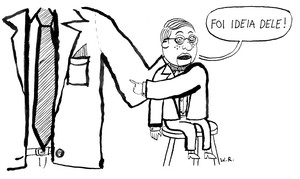 Walter Rego
Walter Rego
Bergmann believes that educational programs should be the focus of the strategy to promote research integrity, but he says that we need to be ready to move when faced with specific problems. He also cautions that “plagiarism can be a malicious act, but in many cases it is due to lack of preparation because students do not know how to cite papers and references and do not really understand the concept of authorship.”
At the University of São Paulo (USP), for example, a dissertation by a master’s student in biology was canceled because he had used data taken by a laboratory colleague and failed to cite credit. “The student justified this by saying that he didn’t know he was committing plagiarism,” says Carlos Gilberto Carlotti Junior, graduate dean at USP. The university awards over 7,000 master’s degrees and PhDs per year and, until recently, used a set of tools and free websites to monitor plagiarism by its students.
In early 2017, USP beefed up this strategy by acquiring Turnitin, a software package developed in 1998 at the University of California, Berkeley, in the United States. It is used in about 15,000 educational institutions in 150 countries, and generates a report that shows the percentage of similarity of a given text compared to a large database, consisting of 62 billion internet pages, 697 million papers produced by students, and 175 million monographs, books, and scientific articles. In addition to paid services such as Turnitin and its main competitor, CheckForPlagiarism.net, there is free software, such as Plagiarism Detector and Duplichecker. Turnitin and CheckForPlagiarism.net scan documents available online as well as documents in actual databases.
At USP, the Technical Department of the Integrated Library System manages Turnitin, and it offers the service to professors who teach at the graduate level. “Using the software helps professors and reinforces their efforts to ensure that an academic paper is of high quality. The advisor’s role is to monitor student projects and identify problems,” Carlotti explains.
 Walter Rego
Walter Rego
The program is effective, but it will not solve the problem on its own. Carlos Frederico de Oliveira Graeff, dean of research at São Paulo State University (Unesp), an institution that also uses the software, cautions that Turnitin has limitations. “For example, sections copied from another colleague or books that are not available online cannot be detected,” he says. Graeff believes that the intention is to use Turnitin as a basis for classroom discussions as well. “Many students think that plagiarism is limited to copying a section of a text without crediting the author. But copying a text and changing a few words to synonyms is plagiarism also, and the software can expose it.”
In 2015, Turnitin released a survey of 1,437 high school, undergraduate and graduate students from every continent. It was found that in half of the academic papers the software checked, more than 50% of the content was not original. Recently, Unesp prepared a report on the use of Turnitin at that institution. Of the 3,000 theses and dissertations defended in 2014, 23% had at least one section that was copied without crediting the original source. This figure dropped to 13% in 2016. Graff assumes that “once students realized that the papers would be checked, they probably thought twice before copying them.”
Specialists and academic administrators agree that the problem surfaces early in a student’s schooling, starting mainly in high school. Partial results of a study coordinated by Sonia Vasconcelos, a professor at the Federal University of Rio de Janeiro (UFRJ), published in 2017 in the Annals of the Brazilian Academy of Sciences, included a survey of 42 high school teachers of biology, chemistry and physics at a federal high school in Rio de Janeiro. The results showed that 41% of the teachers believed that students are not committing plagiarism when they cite the source in the bibliography but copy part of the text without using quotation marks or stating that the section was taken from another work. According to the study, this suggests that many teachers have questions about the concept of plagiarism. It was also observed that half of the teachers interviewed said that they never or rarely received guidelines for plagiarism while they were undergraduates. UFRJ is a pioneer in developing scientific integrity programs in Brazil (see Pesquisa FAPESP No. 233), and in 2014 it made Turnitin available to detect plagiarism in papers written by students. The software is no longer offered to professors due to budget cuts at the institution.
“With the advent of digital media in recent decades, students who have just begun their university studies are unfortunately very accustomed to using Google for academic work,” says Esper Cavalheiro, dean of graduate studies and research at the Federal University of São Paulo (Unifesp). “This problem must be addressed early in schools; otherwise, the practice will continue to cause problems at the undergraduate level.” Recently the university established an Academic Integrity Commission. Among other activities, the commission prepares educational programs to fight plagiarism. An online course for undergraduate and graduate students should be offered soon. “The idea is that all students who enroll at Unifesp, and especially those who have just completed high school, are required to go through the training,” Cavalheiro says.
Republish